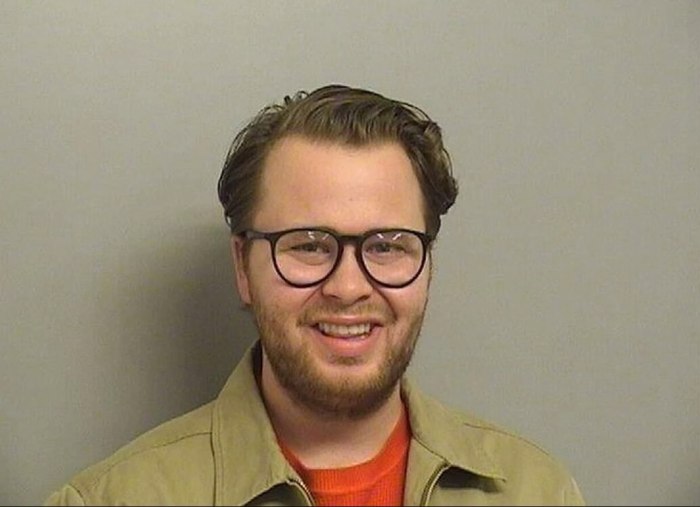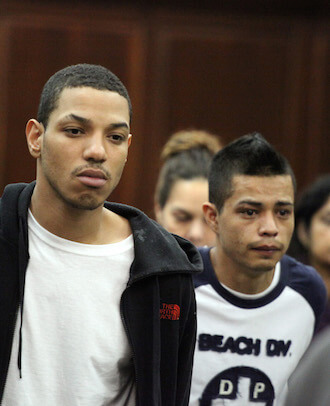The man who is accused of killing Mark Carson in 2013 was nearly shot himself moments after the Carson shooting by the police officer who captured him a few blocks from where Carson lay dead in the street.
“At this point, I’m about to shoot you,” said Henry Huot, a police officer who was on patrol on MacDougal Street, while being cross-examined by Elliot Morales, 36, who is representing himself in the murder trial. “I hear you say, ‘Shit, shit, shit,’ and I see you losing control of your gun… It was going to be a gun battle.”
In what witnesses have described as a confrontation that began on Sixth Avenue and moved to West Eighth Street, Morales first argued with Carson, a 32-year-old gay man, then displayed a silver revolver. As Danny Robinson, Carson’s longtime friend, tried to calm the argument, Morales allegedly fired a single shot at Carson’s head.
Police officer Henry Huot said he was ready to fire until suspect dropped his gun
Alerted by a 911 call made by Robinson and by a second witness, Ryan Kendall, who waved down a police car, police broadcast a description of the shooter as a black or Hispanic male wearing a gray hoodie and shorts.
Heading north on MacDougal Street in response to the call, Huot saw a man dressed in a gray hoodie wearing shorts coming toward him. He first asked the man to stop, then ordered the man to stop as the man walked past him. He repeated orders to stop as he followed the man, who was quickening his pace. The man turned on to West Third Street, and Huot, following instructions he learned at the police academy just 18 months earlier, made a wide turn that took him out to where the curb meets the road bed. He saw the man crouch, begin to spin around with a silver gun in his hand, and then lose the gun.
“At what point did you take out your gun?” Morales asked during February 24 testimony.
“When I saw your silver gun,” Huot said. “The muzzle was within range. The barrel of the gun was pointing at my direction, at me.”
With the gun out of the man’s hand, Huot pounced on the man’s back and took him to the ground. He handcuffed him and saw the gun sitting on the sidewalk, inches away. He placed his knee on the man’s back to hold him down and put his foot on the gun. Huot radioed for assistance.
“I definitely needed back-up,” Huot said when questioned earlier in the day by Shannon Lucey, the assistant district attorney who is prosecuting the case. “I was alone.”
Huot also testified to the first of several statements Morales made to police after the shooting. As he held him down, Morales said, “He thought he was tough and I shot him,” Huot testified when questioned by Lucey.
“It sounded evil, demonic,” Huot said in response to Lucey. “It sounded like he was bragging.”
Morales is charged with second-degree murder as a hate crime, menacing, and weapons possession in the case. So far, multiple witnesses have identified him as the man they saw using anti-gay slurs as he argued with Carson and Robinson, who is the only witness yet who said he saw Morales shoot Carson. Other witnesses have testified to hearing the shooting, seeing the weapon, or seeing the argument, but have not identified Morales.
On February 23 and 24, two employees from a West Village restaurant testified that Morales was the man who entered the business the evening of the Carson killing and spent 10 to 15 minutes using anti-gay slurs. He allegedly displayed a silver gun in the restaurant.
After burning through seven attorneys and insisting early in the case that he be allowed to represent himself, Morales has had moments when he performed well and others when he made errors.
He has, with some success, compared witnesses’ grand jury testimony to what they said on the stand to raise doubts about their memory. With police officers in particular, he has been willing to use his questions and some answers to strongly suggest that they are lying. Defense attorneys generally do not do that because police, or any witness, will not admit to it if they are lying and some jurors may respond badly to that tactic.
On February 23, Philippe Danielides testified to seeing the argument, seeing one of the three men “pull a weapon out of his pants,” and hearing the shot. Lucey did not ask him if he saw the man with the weapon in court, suggesting that she knew he was unable to identify Morales. On cross-examination, Morales asked Danielides, “Do you see that individual in this courtroom?” and he responded, “You kind of look like him.”
On February 24, Morales had an objection sustained by A. Kirke Bartley, the judge in the case, when Lucey was questioning Huot and he began to detail the description of the shooter that police broadcast. But when he cross-examined Huot, Morales asked questions that allowed Huot to provide that description.
The trial continues in Manhattan Supreme Court on February 25.



































